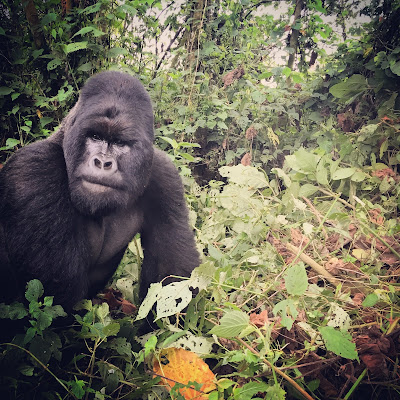The parameters were fairly simple: organize a fun honeymoon.
It doesn’t have to be ultra luxurious, but throw in a nice place or two, and sprinkle
in a few special moments. So there are the organized special moments and the
unorganized ones, and despite the concept of starting with our basic Wilderness
Camp and ending with the beautiful honeymoon suite at Rubondo Island Camp, the
wilderness experience set the bar high for the rest of the trip.
Like this elephant scene before we’d even got to camp.
 |
| A herd of elephant walk along the edge of Silale Swamp in Tarangire. |
Or arriving in camp with this light, and a welcoming party
of 200 zebra.
 |
| Our wilderness camp- a fantastic option for those who seek an exclusive experience but are less concerned about the amenities offered by luxury lodges and camps. |
Or this leopard sighting less than half a kilometer from camp.
 |
| It had been a long and productive morning, but as we sat
down for lunch, I heard a vervet monkey bark out an alarm. Instead of the all
too appealing siesta after lunch, I hopped into the vehicle to investigate. It
was hot and quiet but I found the vervet monkey in a fruiting fig tree. A
bushbuck startled, and a few tsetse flies entered the car and began buzzing
around in the foot-well of the driver’s seat. The vervet, who had been quiet
barked again, but rather half-heartedly. Then out of the corner of my eye, I
noticed dangling antelope legs in the top of an Acacia. Lifting my binoculars
to my eyes, there on the branch I saw a beautiful leopard fast asleep in the
tree with a young hartebeest that it has stashed. |
 |
| This is what a tired cat looks like! |
From Tarangire we headed up to Lake Natron, a special environment
and perfect for things like swimming in waterfalls, watching the sunset with
hundreds of flamingo in front of you, and flying over the dramatic landscape.
 |
| Incredible salt deposits on Lake Natron from the air in a ultra-light plane. Photo credit: Zac Peterson. |
 |
| Honeymoons are supposed to have waterfalls in them right? |
 |
| A beautiful setting for a sundowner with the rift valley and Oldonyo Lengai the backdrop. |
I could easily stay longer, but with limited time, it was
time to head to Serengeti for more wildlife. After the long drive we pulled
into camp, and before the manager could finish his welcome briefing, two
massive male lions began to roar not half a mile away. As you can imagine, we
got back in the vehicle (with the camp staff, who couldn’t stop giggling) and
followed the lions as they walked and roared into the darkness.
 |
| The Serengeti sunset makes for a special moment. |
After a couple of full days of wildlife experiences we
boarded a small plane to Rubondo Island. Rubondo Island and the Camp that
Asilia manages offer such a different experience to the traditional savannah
safari that I would love to include it in every itinerary. It was meant to be
the finale of the honeymoon, the relaxation part, but as we met for drinks
around the fire it was clear that instead of resting we’d be exploring. The
next morning, before the sun rose, after a nice French-press coffee with hot
milk and camp-made cookies, we set off for a dawn canoe trip along the shores of
the island. It was beautiful: African fish eagles calling, hippos ducking away,
a sheltered bay with hundreds of egrets, jacanas, and various stork species. We
returned to breakfast, and the news that the trackers had found the chimpanzees.
 |
| Dawn kayak on Lake Victoria. |
After little deliberation we asked for packed lunches and
set off across the island to find the chimps. After an initial drive, we began
to trek up a hill past one of the chimps’ favorite nesting sites to a “calling
site” where the trackers listened for chimps calling. A rain storm had allowed
the chimpanzees to slip away and while we tried to find them their silence
meant it wasn’t likely that we would see them. Instead we wandered the trails,
soaking up the forest, tasting fruit that was ripe, spooking bush-pig, and
enjoying the bird chorus.
As we drove back to the camp, the radio crackled:
“Can you please ask if they still want to fish?”.
It was late in the afternoon, and the whole relaxation thing
wasn’t going to happen.
“Yes, please get the boat ready because we won’t have much
time”.
 |
| Not a bad ending to a day on Rubondo Island. |
Deus smiled as we boarded the boat, there really wasn’t much
time. Quickly showing the novice fishers how the rods worked we began to troll,
the sun quickly dropping in the sky. “Zzzzzzz” went the line, “Fish!” said
Deus, but we were too slow: 1-0 to the fish. “Zzzzzzz” went the line, “Fish!”
said Deus. This time it was hooked. Reeling it in we could see it was a good
size but then suddenly the line went slack. 2-0 to the fish. We laughed. Another
bite, this time the fish did not get away and we’d caught our dinner. It was
time to head back so we began to troll back toward camp. “Zzzzzzz” went the
line, “Fish!” said Deus and we began to reel in our 4
th bite,
“Zzzzzzz” went the line, “Double!” said Deus…. and so ended the honeymoon.

















































